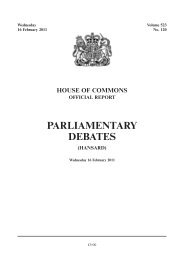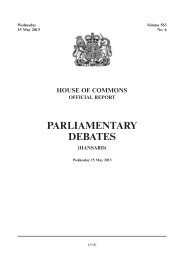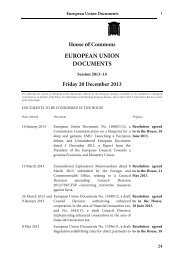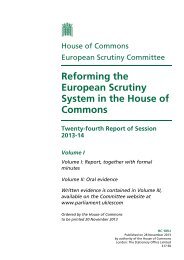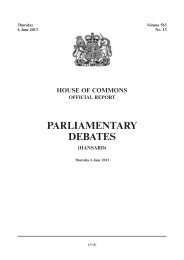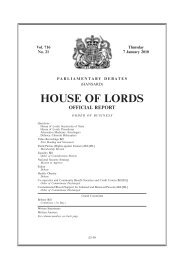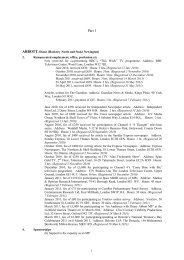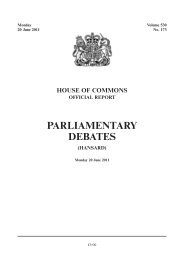Ticketing and Concessionary Travel on Public Transport - United ...
Ticketing and Concessionary Travel on Public Transport - United ...
Ticketing and Concessionary Travel on Public Transport - United ...
Create successful ePaper yourself
Turn your PDF publications into a flip-book with our unique Google optimized e-Paper software.
Ev 128 <strong>Transport</strong> Committee: Evidence<br />
— It facilitates better service planning <str<strong>on</strong>g>and</str<strong>on</strong>g> optimisati<strong>on</strong>.<br />
— It reduces operating costs in certain circumstances.<br />
— Stolen or fraudulent cards can be hot-listed <str<strong>on</strong>g>and</str<strong>on</strong>g> prevented from use.<br />
— It enables accurate apporti<strong>on</strong>ment of revenue between diVerent operators <str<strong>on</strong>g>and</str<strong>on</strong>g> modes of transport.<br />
— The smartcard increases passenger flows through gated stati<strong>on</strong>s <str<strong>on</strong>g>and</str<strong>on</strong>g> <strong>on</strong> buses.<br />
— It enables Local Authorities to provide c<strong>on</strong>cessi<strong>on</strong>ary travel to students <str<strong>on</strong>g>and</str<strong>on</strong>g> pensi<strong>on</strong>ers etc <str<strong>on</strong>g>and</str<strong>on</strong>g> to<br />
obtain accurate usage informati<strong>on</strong> as a basis for reimbursing transport operators.<br />
— Reducing cash transacti<strong>on</strong>s <str<strong>on</strong>g>and</str<strong>on</strong>g> increasing electr<strong>on</strong>ic payment methods can achieve significant<br />
savings. (Cash h<str<strong>on</strong>g>and</str<strong>on</strong>g>ling is costly <str<strong>on</strong>g>and</str<strong>on</strong>g> more open to fraud). Reduced cash h<str<strong>on</strong>g>and</str<strong>on</strong>g>ling also provides<br />
better security, particularly for bus operators.<br />
— Businesses can be incentivised to provide employee passes for business use, <str<strong>on</strong>g>and</str<strong>on</strong>g> receive m<strong>on</strong>thly,<br />
itemised billing.<br />
— Smartcards provide opportunities for n<strong>on</strong>-transport related, sec<strong>on</strong>dary revenue generati<strong>on</strong> e.g.<br />
combined travel <str<strong>on</strong>g>and</str<strong>on</strong>g> theatre / sports admissi<strong>on</strong> tickets, parking, c<strong>on</strong>gesti<strong>on</strong> charging payment, etc.<br />
5.7 It has taken political leadership from <strong>Transport</strong> for L<strong>on</strong>d<strong>on</strong> (with the oVer to fund the installati<strong>on</strong><br />
of Oyster PAYG equipment) to get the TOCs operating in L<strong>on</strong>d<strong>on</strong> to accept Oyster PAYG <strong>on</strong> their services.<br />
This shows the importance of having a centralising, co-ordinating integrator.<br />
Revenue Protecti<strong>on</strong> <str<strong>on</strong>g>and</str<strong>on</strong>g> the Powers of Ticket Inspectors<br />
6. Is the legal framework within which ticket inspectors functi<strong>on</strong> appropriate?<br />
7. What appeal mechanisms exist for passengers, <str<strong>on</strong>g>and</str<strong>on</strong>g> are they adequate?<br />
8. Are the rights of passengers <str<strong>on</strong>g>and</str<strong>on</strong>g> the powers of ticket inspectors well-balanced?<br />
TranSys is not qualified to resp<strong>on</strong>d to these questi<strong>on</strong>s.<br />
9. Do operators of public transport take adequate measures to protect fares revenue?<br />
The extent of fare evasi<strong>on</strong> is extremely diYcult to quantify <str<strong>on</strong>g>and</str<strong>on</strong>g> the incremental business case for gating<br />
additi<strong>on</strong>al stati<strong>on</strong>s cannot always be made within the durati<strong>on</strong> of a franchise. A nati<strong>on</strong>al integrated ticketing<br />
system would perhaps enable better revenue capture overall by the extensi<strong>on</strong> of gating to more stati<strong>on</strong>s as<br />
a result of a l<strong>on</strong>ger term holistic view being taken rather than an incremental business case for each stati<strong>on</strong>.<br />
Clearly <strong>on</strong> trams <str<strong>on</strong>g>and</str<strong>on</strong>g> buses it is not cost eVective or it is physically impossible to provide suitable automatic<br />
entry <str<strong>on</strong>g>and</str<strong>on</strong>g> exit gates <str<strong>on</strong>g>and</str<strong>on</strong>g> in these circumstances revenue protecti<strong>on</strong> pers<strong>on</strong>nel need to be employed, but there<br />
are limitati<strong>on</strong>s as to their capabilities to restrict fare evasi<strong>on</strong> during the morning <str<strong>on</strong>g>and</str<strong>on</strong>g> evening peaks.<br />
<str<strong>on</strong>g>C<strong>on</strong>cessi<strong>on</strong>ary</str<strong>on</strong>g> Fares—the Right Strategy?<br />
10. Is the Government’s c<strong>on</strong>cessi<strong>on</strong>ary fares strategy, including the proposed scheme for c<strong>on</strong>cessi<strong>on</strong>ary bus<br />
travel, adequate?<br />
11. Are c<strong>on</strong>cessi<strong>on</strong>ary fares schemes suYciently integrated across diVerent modes of transport <str<strong>on</strong>g>and</str<strong>on</strong>g> diVerent<br />
geographical areas?<br />
TranSys is not qualified to resp<strong>on</strong>d to these questi<strong>on</strong>s.<br />
March 2007<br />
Supplementary memor<str<strong>on</strong>g>and</str<strong>on</strong>g>um from TranSys (TPT 19a)<br />
ITSO <str<strong>on</strong>g>and</str<strong>on</strong>g> Oyster—Technical Implementati<strong>on</strong> <str<strong>on</strong>g>and</str<strong>on</strong>g> Issues<br />
Introducti<strong>on</strong><br />
The PRESTIGE Project c<strong>on</strong>tract was signed <strong>on</strong> 14 August 1998 after years of investigatory trials <str<strong>on</strong>g>and</str<strong>on</strong>g><br />
negotiati<strong>on</strong>s. ITSO was formed in December 1998 to develop a specificati<strong>on</strong> for an interoperable smartcard.<br />
ITSO comprises authorities <str<strong>on</strong>g>and</str<strong>on</strong>g> operators of each public transport sector, as well as system <str<strong>on</strong>g>and</str<strong>on</strong>g> equipment<br />
suppliers <str<strong>on</strong>g>and</str<strong>on</strong>g> is supported by the Department of <strong>Transport</strong> (DfT). Its primary objectives are to:<br />
— Develop a specificati<strong>on</strong> for an interoperable public transport smartcard across the UK.<br />
— Encourage implementati<strong>on</strong> of the specificati<strong>on</strong>.



